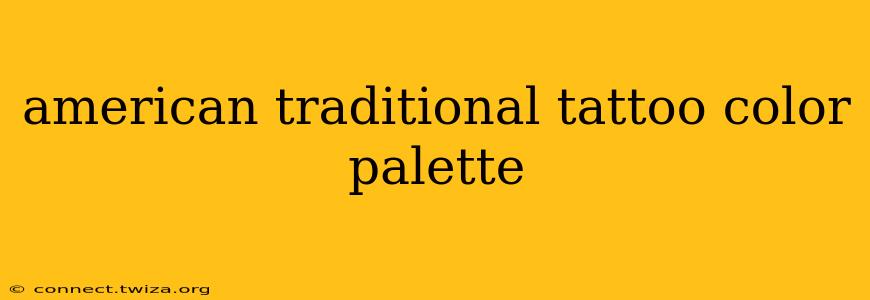American Traditional tattoos, also known as "Old School" tattoos, are instantly recognizable for their bold lines, classic imagery, and vibrant color palettes. This style, which originated in the early 20th century, continues to inspire tattoo artists and enthusiasts today. Understanding the characteristic color palette is crucial to appreciating and recreating this iconic aesthetic. This guide delves deep into the core colors, variations, and the reasons behind their enduring popularity.
What are the main colors used in American Traditional tattoos?
The American Traditional palette is surprisingly limited, relying on a core set of vibrant, saturated colors that provide maximum impact and readability, even from a distance. These primary colors form the foundation:
-
Bold Red: A deep, almost crimson red is a staple. Think less of a bright cherry red and more of a rich, slightly darker shade that maintains its vibrancy without appearing too garish.
-
Classic Black: Black isn't just an outline color; it's a crucial element in shading and adding depth to the design. A deep, matte black is preferred, offering sharp contrast and preventing the piece from looking muddy.
-
True Blue: A strong, almost cobalt blue is frequently used, providing a bold contrast against the red and black. Avoid pastel or light blues; the color should be saturated and intense.
-
Bright Yellow: A sunny, almost canary yellow adds brightness and pops of color to the design. This yellow isn't muted or pale; it needs to be striking and attention-grabbing.
-
Deep Green: Often a forest green or an emerald green, this color provides a grounding element and adds another layer of depth. It’s not the bright green of spring, but rather a deeper, more mature hue.
What other colors are sometimes used?
While the core colors remain consistent, some artists incorporate subtle variations or additions to expand the palette slightly. These might include:
-
Orange: A fiery orange can be used effectively, but often in smaller accents rather than large blocks of color.
-
Purple: A deep, rich purple is sometimes incorporated, though it's less frequent than the primary colors.
-
Pink: A bold, almost magenta pink can be found, usually in smaller areas or as highlights.
Why are these colors so important to the style?
The limited palette is key to the American Traditional aesthetic. The bold, saturated colors were chosen for their ability to hold up well over time, especially considering the limited tattoo technologies of the past. The colors need to remain vibrant even after decades, and these deep, rich shades have proven their longevity. Furthermore, the simplicity of the color scheme ensures that the design remains clear, easily readable, and visually striking.
Are there variations in the color palette?
While the core colors remain constant, subtle variations exist. Some artists might slightly adjust the shades to create unique results or to better suit their personal styles. However, the general principle of bold, saturated hues remains central to the American Traditional style.
How do I choose the right colors for my American Traditional tattoo?
The best approach is to collaborate closely with your tattoo artist. They possess the expertise to guide you towards colors that will work best with the specific design, your skin tone, and the desired effect. Show them examples of American Traditional tattoos you like, focusing on the color schemes that appeal to you most.
What about shading and blending in American Traditional tattoos?
Shading in American Traditional tattoos is usually achieved through the strategic use of black and occasionally other dark colors, such as a deep green or blue, rather than elaborate blending techniques. This keeps the style bold and graphic, emphasizing sharp lines and clean color blocks.
By understanding the core elements of the American Traditional tattoo color palette, you'll be better equipped to appreciate and discuss your own tattoo design with your artist, ensuring a beautiful and lasting piece of art.
